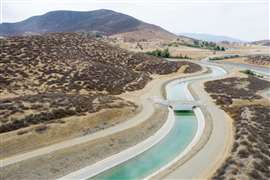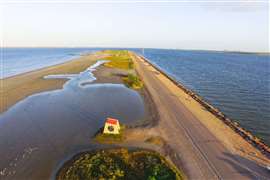Read this article in French German Italian Portuguese Spanish
Inside an unusual project to increase the height of 70-year-old dam
06 December 2024
Gross Reservoir located just west of Denver, Colorado, US, is a vital water source for the inhabitants of the state’s largest city, and it’s currently undergoing a major expansion project that will increase the reservoir’s dam height by about 40m. But why is this 70-year-old dam getting a literal lift, and how are construction crews making it happen?
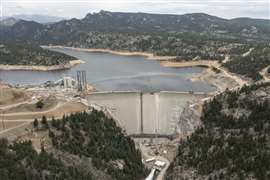 Construction crews work on raising a dam at Gross Reservoir near Denver, Colorado, US. (Image: Doka)
Construction crews work on raising a dam at Gross Reservoir near Denver, Colorado, US. (Image: Doka)
Nestled within the foothills of the Rocky Mountains, the Gross Reservoir is in a remote locale situated within a tightly contained mountainous region.
It may lie low in a valley surrounded almost entirely by wilderness, but it serves a bustling - and growing - metro area about 20 miles (32 kilometres) southeast.
While raising a dam is a relatively unusual procedure, the possibility was conceived as part of its original design and construction seven decades ago, Douglas Raitt, engineering manager of construction/dam safety for public utility agency Denver Water, tells Construction Briefing.
Since it was built, the population of the city has nearly doubled from about 400,000 people to more than 700,000 today, and so the time for the complex US$531 million project has come.
Raitt notes initial estimations were for an increase in height of about 37m, but the project team settled on 40m (131 ft). The existing infrastructure is a gravity dam made of conventional concrete. The new dam will use roller-compacted concrete in a stepped formation, creating an arch dam, which is a departure from initial plans made in the 1950s, Raitt notes. Additionally, the project is installing concrete and steel within the steps, which will run roughly 40m up the downstream side of the dam.
Of the expansion work, Raitt adds, “Essentially, it’s a five-year project to construct this new concrete dam buttress against the existing Gross Dam, which is itself 340-ft [104m] high.” The final extension will make the entire dam 471-ft (144m) tall.
Additional construction includes a new spillway, training walls and incising work on the original dam’s spillway section.
Once complete, Raitt says the reservoir is expected to collect more snowpack (Denver’s main source of municipal water) in general, but also better store and deliver it the metro population. The dam also produces hydroelectric power, which will reach an 8.1MW capacity once the project concludes. Denver Water believes it will be the largest dam-raising project in the US and largest RCC dam-raise worldwide.
Key planning started in 2018 with construction crews commencing work in spring 2022. Construction is expected to finish in 2027.
Project Details
Name: Gross Reservoir Expansion
Location: Golden, Colorado, US
Construction contractors: Kiewit Infrastructure and Barnard Construction
Civil engineer: Stantec
Cost: US$531 million
How the Gross Reservoir is getting taller
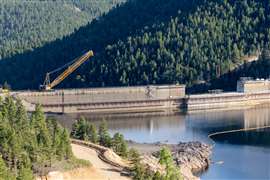 A view from the reservoir side of the Gross Reservoir dam in Colorado, US, from 2023. Construction started in 2022 to raise the dam about 40m, with project completion scheduled for 2027. (Image: Adobe Stock)
A view from the reservoir side of the Gross Reservoir dam in Colorado, US, from 2023. Construction started in 2022 to raise the dam about 40m, with project completion scheduled for 2027. (Image: Adobe Stock)
There’s been a host of unique construction solutions, particularly with concrete placement and formwork, utilised on the Gross Reservoir project.
“The new dam is a curved arch, so we’re putting an arch on top of the gravity dam. It provides a little bit more of a slender structure but takes advantage of canyon walls it’s butted-up against,” Raitt explains, noting the arch portions will also use roller-compacted concrete (RCC). “We’re adding about 840,000 cubic yards [642,226 cubic metres] of mostly RCC, but this dam does have a conventional concrete facing, and the new crest elevation is at 7,421 feet [2,262 metres].”
In addition to work at the top, a new stepped system will be installed from the ground up using a mix of RCC and steel-face panels. “We wanted this structure to have a very durable finish. We want it to last millennia,” adds Raitt.
Raitt anticipates that near the end of November would be the final call for concrete placement for the year. “By the second week in November, the freezing temperature we get up here overnight really start to creep into the day, and that’s the end of the season for RCC,” he says.
As of publication, Raitt estimates about two-thirds of the concrete has been laid for the project. The concrete will continue to pour with warmer weather in 2025.
Innovative formwork on Gross Reservoir project
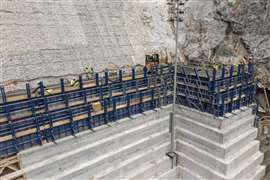 The steps of the Gross Reservoir dam in Colorado, US, present a challenege needing unique formwork solutions. (Image: Doka)
The steps of the Gross Reservoir dam in Colorado, US, present a challenege needing unique formwork solutions. (Image: Doka)
Austria-based formwork and scaffolding producer and supplier Doka is working the site with its Xclimb 60 climbing formwork solution, its framed Framax S Xlife formwork system, as well as its DokaXact Load & Pressure digital sensors.
Doka says, “The formwork system incorporates horizontal adjustment to maintain tie spacing as the dam face steps back with each lift, ensuring both aesthetic alignment and structural integrity.”
Doka adds the formwork assembly is designed in a way that allows a single 1.2m-lift per 24 hours.
Doka engineers tell Construction Briefing the mountainous environment, the aged structure, and the use of RCC all brought different challenges to the table and prompted them to devise unique solutions in response. “Specially made panels were created that can be adjusted or extended using slip plates and extension panels to change the formwork’s length to match the structure’s changes in length at each step,” the team says.
Also unique to Gross Reservoir is its stepped design, which Doka calls “a new obstacle.”
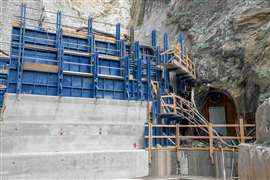 A close-up of Doka’s custom formwork solutions on the Gross Reservoir Expansion project. (Image: Doka)
A close-up of Doka’s custom formwork solutions on the Gross Reservoir Expansion project. (Image: Doka)
“This shape made it necessary for us to use completely new custom formwork panels,” Doka engineers say. “With these custom panels, we can connect three steps of panels together allow for proper load transfer between panels.”
But due to the dam’s shape, the length of each step changes as the work progresses.
“This means that the corners take most of the design time to ensure that we account for all the changes in lengths at each step while also ensuring that we are aligned with the two steps below the pouring step to transfer the loads to the existing steps,” the team says.
Getting technical on the Gross Reservoir dam expansion
Helping matters is a 3D workflow, which Doka crews are using to aid comprehension and provide detailed accuracy.
“We developed an automated solution using the newest software to write a script that analysed our design in a 3D workspace. The software would then list the pinpoint coordinates of each endpoint of a panel in order from east to west,” say the engineering team.
As the project progresses, Doka adds it will install DokaXact Load and Pressure sensors for real-time concrete monitoring.
STAY CONNECTED



Receive the information you need when you need it through our world-leading magazines, newsletters and daily briefings.
CONNECT WITH THE TEAM









